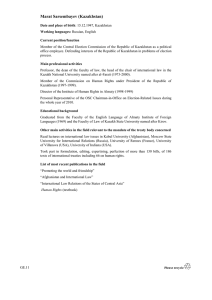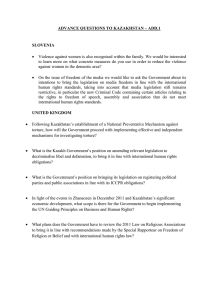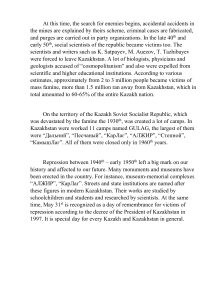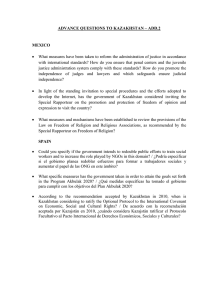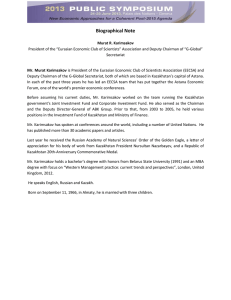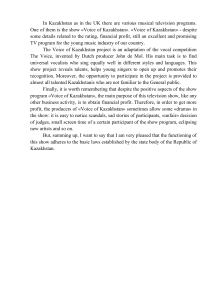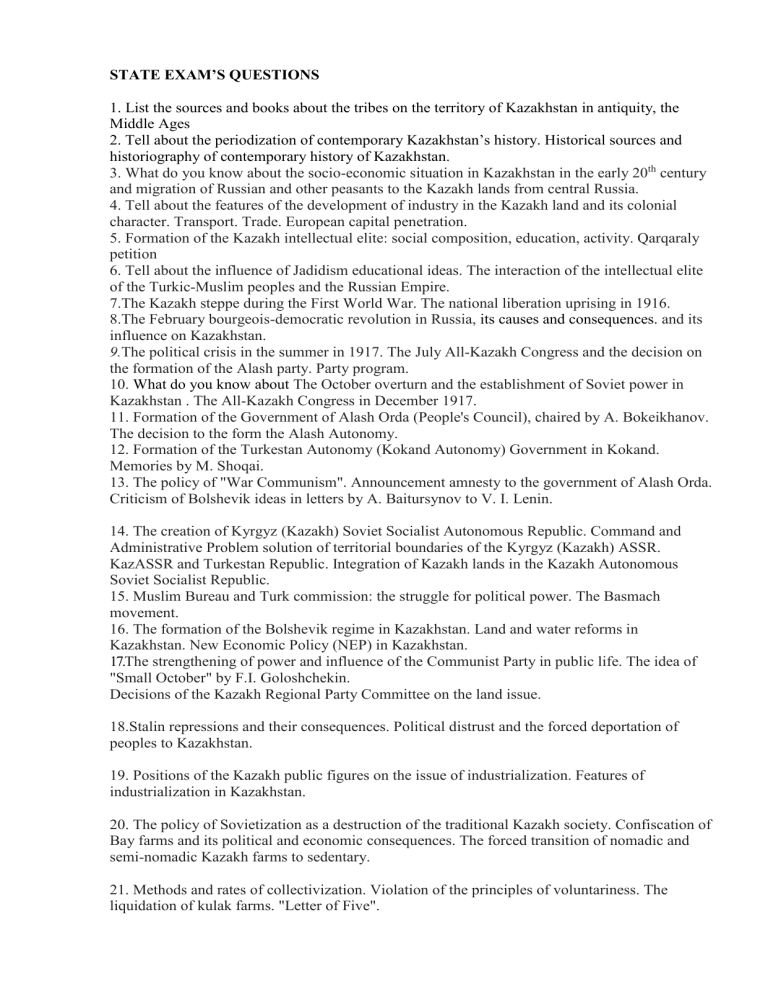
STATE EXAM’S QUESTIONS 1. List the sources and books about the tribes on the territory of Kazakhstan in antiquity, the Middle Ages 2. Tell about the periodization of contemporary Kazakhstan’s history. Historical sources and historiography of contemporary history of Kazakhstan. 3. What do you know about the socio-economic situation in Kazakhstan in the early 20th century and migration of Russian and other peasants to the Kazakh lands from central Russia. 4. Tell about the features of the development of industry in the Kazakh land and its colonial character. Transport. Trade. European capital penetration. 5. Formation of the Kazakh intellectual elite: social composition, education, activity. Qarqaraly petition 6. Tell about the influence of Jadidism educational ideas. The interaction of the intellectual elite of the Turkic-Muslim peoples and the Russian Empire. 7.The Kazakh steppe during the First World War. The national liberation uprising in 1916. 8.The February bourgeois-democratic revolution in Russia, its causes and consequences. and its influence on Kazakhstan. 9.The political crisis in the summer in 1917. The July All-Kazakh Congress and the decision on the formation of the Alash party. Party program. 10. What do you know about The October overturn and the establishment of Soviet power in Kazakhstan . The All-Kazakh Congress in December 1917. 11. Formation of the Government of Alash Orda (People's Council), chaired by A. Bokeikhanov. The decision to the form the Alash Autonomy. 12. Formation of the Turkestan Autonomy (Kokand Autonomy) Government in Kokand. Memories by M. Shoqai. 13. The policy of "War Communism". Announcement amnesty to the government of Alash Orda. Criticism of Bolshevik ideas in letters by A. Baitursynov to V. I. Lenin. 14. The creation of Kyrgyz (Kazakh) Soviet Socialist Autonomous Republic. Command and Administrative Problem solution of territorial boundaries of the Kyrgyz (Kazakh) ASSR. KazASSR and Turkestan Republic. Integration of Kazakh lands in the Kazakh Autonomous Soviet Socialist Republic. 15. Muslim Bureau and Turk commission: the struggle for political power. The Basmach movement. 16. The formation of the Bolshevik regime in Kazakhstan. Land and water reforms in Kazakhstan. New Economic Policy (NEP) in Kazakhstan. 17.The strengthening of power and influence of the Communist Party in public life. The idea of "Small October" by F.I. Goloshchekin. Decisions of the Kazakh Regional Party Committee on the land issue. 18.Stalin repressions and their consequences. Political distrust and the forced deportation of peoples to Kazakhstan. 19. Positions of the Kazakh public figures on the issue of industrialization. Features of industrialization in Kazakhstan. 20. The policy of Sovietization as a destruction of the traditional Kazakh society. Confiscation of Bay farms and its political and economic consequences. The forced transition of nomadic and semi-nomadic Kazakh farms to sedentary. 21. Methods and rates of collectivization. Violation of the principles of voluntariness. The liquidation of kulak farms. "Letter of Five". 22. Demographic consequences of hunger. The plight of agriculture in Kazakhstan in 1930s. The consequences of the class-party principle in social and political life, culture, education and science. 23. Creation of education system. Fight against illiteracy. Socialist realism in literature and art. Theater and musical art. Creative activity of writers and composers of Kazakhstan. 24. The main directions of foreign and domestic policy of the Soviet state before the Second World War. Socio-political, socio-economic and cultural situation in Kazakhstan. The beginning of War. 25. The Labor feat of Kazakhstani in the rear front during the War (1941-1945). The heroism of workers. Evacuation of peoples, industrial enterprises and cultural facilities in the regions of Kazakhstan. 26.Participation of Kazakhs in the front-line actions and partisan movement. Heroes of the Soviet Union from Kazakhstan. Results and lessons of the Second World War. 27. Kazakhstan in the Post-War years. The complexity of the transition to peaceful construction. Problems and difficulties in the national economy of Kazakhstan. 28. Positive changes in education and science Post-War years. Creation of seven years education system. The opening of higher and secondary special educational institutions. Formation of the vocational education system. Final creation of the Kazakh Academy of Sciences. 29. Criticism of Stalin’s "Personality Cult" period. Political rehabilitation of state and public figures. 30. Events in Temirtau. Increased restrictions in the national question. The incomplete nature of reform actions. 31. T.Rysqulov, his role in the history of Kazakhstan. 32. Ideological crisis. The hidden opposition of the intellectuals and the activities of dissidents. The role of informal student organizations by Kazakh youth in national identity (“Jas Tulpar”). 33. The ecological tragedy of Kazakhstan in the XX century: ecological disaster, causes and consequences. The tragic damage inflicted on the Kazakh people by the Soviet regime. 34. Semipalatinsk nuclear test site (1949-1991), its causes and consequences. Genetic changes, mass distribution cancer and mental illness among the local population as a result of atomic radiation. 35. Policy of liquidation of illiteracy in 20 years ("Red yurts"), its reasons and results. 36. The process of establishment of the Soviet power in Kazakhstan. 37. The participation of Kazakhstan in restoration of the Soviet economy after the Second World War. 38. The national-liberating revolt of 1916 (causes, peculiarities, main locations). 39. "Cultural revolution" - the basis of socialism construction (1920-1940). The achievements. 40. Socio-economic development of the Soviet Kazakhstan in the 1960s. Policy of Tselina (1954). 41. Main battles in the Great Patriotic War in 1941-1945. The heroes of Kazakhstani at the battle fields 42. The doctrine of the Russian Turkism. The role of "Ittifaq al-Muslimin" in the consolidation of the Turkic-Muslim peoples 43. The program of industrialization of Kazakhstan 1925-1939. Its positive and negative consequences 44. The role and place of movement "Alash Orda" in the history of Kazakhstan. The secular elite of Kazakhstan in the early 20th century. 45. Solid collectivization of agriculture in the USSR and Kazakhstan (1928-1940). Its results and values. 46.Describe the situation in Kazakhstan during repressions in Kazakhstan in 1936-1938 47.Analyze the Transfer of the capital from Almaty to Astana\Nur-Sultan 48.Tell about the activity of Kunayev D.A. as the First Secretary of the Central Committee of the Communist Party of Kazakhstan. Define the achievements of policy. 49.Describe the Socio-economic development of the Soviet Kazakhstan in the 1960s: explain the Policy of Tselina (1954) as a famous campaign. 50.Define the reasons of migration and famine in 1920-30 in Central Asia and Kazakhstan. 51.What the results of the national conflicts in the Soviet Union in 1980s`? 52.State the main battles in the Great Patriotic War in 1941-1945 and Name The heroes of Kazakhstani at the battle fields 53.Tell about the continuity of state program and strategy of the Republic of Kazakhstan 2020, 2030 and 2050 54.Tell about the December events of 1986 in Almaty and in other cities of the republic and their true causes. 55.Explain the collapse of the Soviet Union: define the causes and consequences on Kazakhstan. The formation of the Commonwealth of Independent States (CIS). 56.Analyze the Adoption of the “Law on Language” and its meaning. 57.Tell about the “Strategy“ Kazakhstan-2050 ”: a new political course of the established state”. 58.The impact of Nazarbayev on establishment of the Peace in the World. 59.Tell about the Definition of a state development strategy for an independent Kazakhstan. 60.Analyze the relationships Kazakhstan and the European Union (1991-2019). 61.Tell about the creation of the armed forces of the Republic of Kazakhstan. Creating a national army. 62.Analyze the Kazakhstani model of economy in the XXI century. 63.What does mean “The Letter of Five”, tell about the Letter of T.Ryskulov to Stalin - the bitter truth. 64."Towards a competitive Kazakhstan, a competitive economy, a competitive nation" Describe this Message of the President of the Republic of Kazakhstan 65.Tell about the key points of Kazakhstan`s foreign policy (1991-2019) 66.Describe the political parties in contemporary Kazakhstan. 67.Tell about the program of Kazakhstan: Industrial and Innovation strategies. 68.Describe the Stalin period: life and political activities in Kazakhstan. Repressions of the intellectuals. 69.Tell about the interethnic and demographic situation after the getting Independence of Kazakhstan. 70.Describe the Development of state identity, strengthening civil peace and political stability 71.Analyze the New economic policy "Nurly Zhol - the path to the future" - Kazakhstan’s response to global challenges 72.Explain the main directions “The Perestroika” policy in Kazakhstan (1985). Tell about the December uprising in 1986 in Alma-Ata. 73.Tell about the main stages of the unification of the people of Kazakhstan as a One Nation. 74.Tell about the formation and the role of the CIS. 75.Compare the policies of “military communism” and NEP in Kazakhstan (1918-1925) (the main economic aspects). 76.Tell about the reform in education sphere and the signing of the Bologna Declaration. 77.Explain the notion “Alash Orda”. Define the purpose and significance of the political movement. 78.Describe the policy by Goloschekin "Small October", and its consequences as a tragedy for the Kazakh people 79.Describe the state symbols of Kazakhstan. 80.Analyze the migration, demographic processes in Kazakhstan, changes in the ethnic structure of the population. 81.Describe economic, social and political developments during “stagnation period”. Define the causes and affect the Soviet Kazakhstan. 82.Tell about "the concept of the formation of the state identity of the Republic of Kazakhstan". 83.Describe the relationships between Kazakhstan and the Great Britain. 84.Classify the Soviet government's policy in Kazakhstan in the field of education in the 1920-1930s. 85.Define the importance for Kazakhstan of holding EXPO-2017. 86.Presidential program "Intellectual Nation 2020" and its significance. 87.Describe the NATO (North Atlantic Treaty Organization) and collaborations with Kazakhstan. 88.Describe the formation of an innovative model of education. 89.Describe the Kazakhstan Declaration of Sovereignty on the 25th of October 1990, and Declaration of Independence in December 16th , 1991. 90.Talk about the history of spiritual and social development of Kazakhstan (1991-2019). 91.Interethnic harmony is the basis for strengthening independence and democracy in the Republic of Kazakhstan. Agree or disagree with this statement and determine why? 92.Tell about the development of political systems of the Republic of Kazakhstan 93.Tell about the 1st Civil Forum and its significance for society. 94.State priorities of the economic development according program Kazakhstan 2050 95.Define the value of the work "The strategy of the development of Kazakhstan as a sovereign state" 96.Tell about the first world kurultai of the Kazakhs. 97.Tell about 1st Congress of Leaders of World and Traditional Religions in Astana (2003). 98.Analyze the reasons of the collapse of the USSR and tell about the formation of the CIS. 99.Tell about the Modern Kazakhstan as the heir of the Great Steppe 100.Describe the aims and objectives of the "Concept of the formation of the state identity of the Republic of Kazakhstan". 101.History of the Kazakhstan national currency tenge (1991-2019) 102.Tell about the multi-ethnic Kazakhstan and role of the Assembly of Kazakhstan People. 103.Describe the main idea of book by N.A. Nazarbayev «People in the stream of history» 104.Talk about Nur-Sultan – a new capital of the RK 105.Analyze the program "100 steps" main contents. 106.Tell us about the importance of article «7 aspects of the Great steppe». 107.Describe the role of the Elbasy, the Leader of the Nation in the political system of Kazakhstan. 108.Tell about works of sons of the Great Steppe: Al Farabi, Zhusip Balasagun, Mahmut Kashgari, Khoja Ahmet Yassaui. 109.Tell about evolution of the Kazakhstani Military Force (1991-2019). 110.Tell about the achievements of the Kazakhstani Government (1991-2019). 111.Analyze the significance of the celebration of the 550th anniversary of the Kazakh Khanate 112.Talk about the role of the Prime Minister in the political system of the Republic of Kazakhstan. 113.Tell about the history of the Constitution of the Republic of Kazakhstan (Constitution of 1993, Constitution of 1995) 114.Analyze the value of the manifesto "Peace. XXI century". 115.Tell about the state program “Rukhani Zhangyru”. 116.Give description «Tenge» as the national currency of the independent Kazakhstan. 117.Analyze the program “Kazakhstan-2050” as a new development strategy. 118.Analyze the role and function of the Assembly of Kazakhstan People. 119.Summarize the role of Kazakhstan’s Chairship in the OSCE in 2010. 120.Tell about the foreign policy of independent Kazakhstan. Name the social development priorities according The Strategic Program “Kazakhstan-2050” 121.Explain the term “Kazakhstan is the successful experience of multiethnic state”. 122.Summarize and determine the value of the work "The strategy of the development of Kazakhstan as a sovereign state" 123.Describe the role of the Nur Otan party in the political system of the Republic of Kazakhstan. 124.Tell about the main ideas of books by N.A. Nazarbayev "In the flow of history" and "Kazakhstani way" 125.Describe the main idea of the state program “Rukhani Zhangyru”. 126.Describe historical significance of the program “Nurly Jol - WAY TO THE FUTURE” 126.Describe and explain the State symbols of Kazakhstan. 127.Explain the main priorities of the strategic development program “Kazakhstan-2030” 128.Explain the “Mangilik El” as the ideological future of Kazakhstan 129.Analyze the role of the United Nations in the world and place of Kazakhstan in Organization 130.Analyze the Constitution of the Republic of Kazakhstan in 1995 and its changes 2017. 131.Tell about the program "Nurly Jol" on the road to prosperity. 132.Analyze Kazakhstan as the new nation in the system of international relations. (Membership in UNO and other organizations). 133.Tell about Kazakhstan Development Strategy -The program “Kazakhstan-2030”. 134.Analyze the role of relationships between members of SCO - Shanghai Cooperation Organization and Kazakhstan. 135.Analyze the program "100 steps" main contents.
